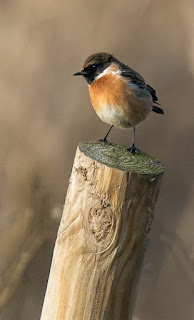Back at the Centre in the dusk, this owl did a quick patrol of the ditches.
Saturday, 28 January 2017
Friday, 27 January 2017
From the Lyle Hide
Further north in the reserve the swans and ducks were less in evidence, and the waders and smaller birds had room to forage. There was a Glaucous Gull among the others species out on the water - first tick for twenty years.
Whoopers
A camera club visit to Welney attracted eleven snappers, who crowded into the South Wing Hide without complaint.
Wednesday, 25 January 2017
Crew Stations
The Comet carried a flight engineer and a navigator. The engineer sat behind the first officer's seat. His panel was, from the top, electrics (four engine-driven alternators) then the engine instruments, which did not include rev counters or EGT gauges, fuel gauges for the seven main tanks and two 'bullet fairing' tanks and finally cabin air and pressurisation controls. The four coloured instruments (yellow, red, blue and green) monitored the four hydraulic systems, and the fuel tank and cross-feed system is schematically arranged (Pic. 2) All the pump and feed switches are protected from inadvertent movement by plastic guards (Pic 3). The main temperatures and weights are metric, as is the fuel flow, but the fuel pressure is in Psi, jettison values in gallons and cabin temperature in degrees Fahrenheit. The navigator's station has two ADF receivers, plus VOR and LORAN. His only instruments are an outside air temperature gauge, a Machmeter and a simple compass as opposed to the normal Direction Indicator.
Tuesday, 24 January 2017
Comet 4
I've been stewarding the Comet while Concorde is refurbished. It's a lovely old-fashioned airliner and people are delighted to be allowed access. The Comet is crewed by two pilots, a navigator and a flight engineer. It has an autopilot (the black box at the bottom of Pic 4) and a Machmeter (bottom instrument on the left of the central panel). The engine instruments are very basic - just an rpm gauge and an EGT meter. There is no APU - power comes from four engine-mounted alternators, as on Concorde.
Sunday, 22 January 2017
Friday, 20 January 2017
Welney Once Again
Lots of noisy Whooper Swans indulging in squadron scrambles and formation flying. Black-Tailed Godwit came up occasionally, and the juvenile Great Black-Backed Gull was a rare sighting.
Wednesday, 18 January 2017
Cambridge Snaps
Photos from yesterday - the old corner unit (formerly the West Cornwall Pasty Company) and the new (a wasabi bar). The market doesn't change much. The lorry was unloading to a nearby food shop across Portugal Place. The weather front was mirrored by the Hardwick Road near Toft.
Tuesday, 17 January 2017
The American Cemetery
On our way into Cambridge, we met a traffic jam on the Madingley Road, so we stopped off at the cemetery, hoping for frosty pix. Black and white seemed to work best. The top pic is from a slide I took from G-BB in 1997
Monday, 16 January 2017
From the Air
It was raining today, so we began scanning some of our old slides. These were taken in the late 1990s from the Beechcraft. Top pic is Denver Sluice, the others are of Southery Beet Factory. I used Kodachrome in an Olympus OM-2 and an 85mm lens with a shutter speed of 1/500th and varying aperture.
Saturday, 14 January 2017
Swans at Welney
It was a cold bright day at the reserve, with an estimated 9000 swans on site. Although it looks frosty, it is just over-exposed water into the light. Also saw a kingfisher, three barn owls, kestrel, buzzard and marsh harrier, but of the waders, only godwit and lapwing.
Sunday, 8 January 2017
The Kestrel
My feet are locked upon the rough bark.
It took the whole of Creation
To produce my foot, my each feather:
Now I hold Creation in my foot
Or fly up, and revolve it all slowly -
I kill where I please because it is all mine.
Nothing has changed since I began.
I am going to keep things like this.
Ted Hughes
A gloomy afternoon at Wicken, with the kestrel keeping it like it is.
Subscribe to:
Comments (Atom)




















































